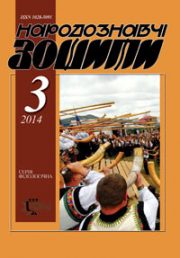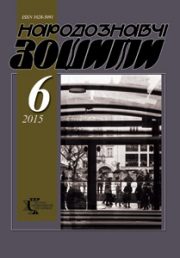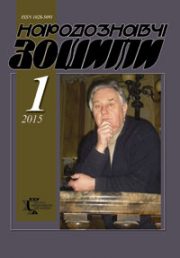The Ethnology Notebooks. 2019, № 5 (149), 1165—1177
UDK 738:39:7.046.1 (4)
DOI https://doi.org/10.15407/nz2019.05.1165
POTTERY THEMES IN THE FOLKLORE RECORDINGS BY MYTROFAN DYKARIV
RAKHNO Kostyantyn
ORCID ID: https://orcid.org/0000-0002-0973-3919
Doctor of Sciences in History,
Leading Researcher of the National Museum
of Ukrainian Pottery in Opishne,
102 Partyzanska Street, 38164, Opishne,
Zinkiv District, Poltava Region, Ukraine
e-mail: krakhno@ukr.net
Abstract. Folklore data are very important for the studies of the role and place of pottery craft in the traditional culture and life of the Ukrainian people. It is the folk oral traditions that allow the most complete coverage of the folk perception of the pottery craft and its carriers — potters as well as understanding the attitude of the Ukrainians to such production stages as the extraction of pottery raw materials, the production of ceramics and their sale. Legends, fairy tales and narratives show us the folk-mythological image of the potter, and songs, sayings, proverbs, sentences, descriptions of family and calendar ceremonies, which are inseparable from folklore, help us to understand better the ritual and magic functions of his products. Not all ethnographic regions of Ukraine are equally researched in this regard. Therefore, the scientific heritage of Mytrofan Dykariv (1854—1899), the famous folklorist, ethnographer, and mythologist, which, in spite of its considerable amount, remains poorly studied, is especially relevant. The goal of the author is to study the pottery folklore presented in it. The object of the contributed study is the Mytrofan Dykariv’s scientific groundwork, which consists of his publications of folk prose, songs, and small forms of folklore, his descriptions of wedding and calendar rituals and customs, folk life, his scientific research in the field of mythology, and its subject are ideas, available in them, which reveal the folk perception of the activity of potters and pottery carriers, the role and function of earthenware in the traditional life of the Ukrainians of the Voronezh and Kuban regions in the late 19th century. Methodological basis of the research is the historical and geographical method in conjunction with the principles and methods of historiographical research.
The basis of the work is mythological legends, recorded by Mytrofan Dykariv, which cause the mythological significance of pottery raw material — clay and the functions of items from it, narratives, proverbs and sayings, which show the attitude of the people to the professions of the potter and pottery carrier. The results of the research elucidate the images of the potter and pottery carrier in the folk mythological beliefs, the people’s attitude to them and their occupations, their relationship to other mythological characters, and also tell about the mythological connotations of ceramic ware. This is, in particular, the tales on a potter’s meeting with a dangerous wizard, didactic stories about a pottery carrier, punished for deceiving people, a narrative about the magic pitcher received by childless spouses from a witch. They have parallels in other regions of Ukraine.
Keywords: pottery, folklore, legends, narratives, wedding ceremonies, calendar ceremonies, sayings, proverbs, songs, Mytrofan Dykariv.
Received 26.07.2019
REFERENCES
Kozar, L. (2008). Ethnologist Mytrofan Dykarev from the Ukrainian-Russian Ethnographic Borderland. In Materials for Ukrainian Ethnology (Vol. 7 (10), pp. 110—116). Kyiv: the Maksym Rylsky Institute of Art Studies, Folklore and Ethnology of the NAS of Ukraine [in Ukrainian].
Dykarev, M. (1891). Voronezh Ethnographic Collection. Voronezh: typolithography of Government Council [in Russian].
Hrinchenko, B.D. (1895). Ethnographic Materials Collected in the Chernihiv and Neighboring Governments (Issue 1). Chernihiv: typography of the Government Council [in Russian].
Dykarev, M. (1895). Christmastide (Excerpts from the Ukrainian Folk Calendar). In Kuban Regional Bulletin, 5, 2 [in Russian].
Kramarenko, M. (1895). Christmastide in the Cossack Village of Pavlivska in the Yeysk district, on the Kuban Black Sea Coast. In Ethnographic Compendium (Vol. I, pp. 1—24). Lviv: Printing House of the Taras Shevchenko Scientific Society [in Ukrainian].
Levchenko, M. (Ed.). (1928). Fairy Tales and Stories from Podillya: In the Records of the 1850s-the 1860s. Compiled by Mykola. (1928). (Issues I—II). Kyiv: Printing House of the Ukrainian Academy of Sciences [in Ukrainian].
Drahomanov, M. (1876). Ukrainian Folk Tales and Stories. Mykhaylo Drahomanov’s Compendium. Kyiv: M.P. Fritz’s typography [in Russian].
Hnatiuk, V. (1899). Galician Ruthenian Anecdotes. In Ethnographic Compendium (Vol. VI). Lviv: Printing House of the Taras Shevchenko Scientific Society [in Ukrainian].
Franko, I. (1898). Five Legends. In Ethnographic Compendium (Vol. V, pp. 111—116). Lviv: Printing House of the Taras Shevchenko Scientific Society [in Ukrainian].
Dykarev, M. (1896). Black Sea Cossack Folk Tales and anecdotes. In Ethnographic Compendium (Vol. II, pp. 3—50). Lviv: Printing House of the Taras Shevchenko Scientific Society [in Ukrainian].
Dykarev, M. (1897). Easter in Ukraine and on the Kuban Black Sea Coast (Excerpts from the Folk Calendar). In Kuban Regional Bulletin, 84, 2 [in Russian].
Dykarev, M. (1896). About the Tsar Riddles. In Ethnographic Review, 4, 1—64 [in Russian].
Chubynsky, P.P. (1878). Proceedings of the Ethnographic and Statistical Expedition to the West-Russian Region, Equipped by the Imperial Russian Geographical Society (Vol. 2. Ukrainian Fairy Tales). St. Petersburg: A. Transhel’s typography and chromolithography [in Russian].
Potebnya, A.A. (1865). About the Mythical Significance of Certain Rites and Beliefs. Moscow: Katkov and Co. University Press [in Russian].
Chubinsky P.P. (1877). Proceedings of the Ethnographic and Statistical Expedition to the West-Russian Region, Equipped by the Imperial Russian Geographical Society (Vol. 4. Rites: Childbirth, Christening, Wedding, Funeral). St. Petersburg: V. Kirschbaum’s typography [in Russian].
Dykarev, M. (1899). A Note on the History of Folk Botany. In Ethnographic Review, 1—2, 19—53 [in Russian].
Dykarev, M. (1899, october). The Ukrainian Word palyanytsya and the Greek релбнпт. Kievan Antiquity (Vol. LXVII, pp. 31—49) [in Russian].
Chubynsky, P.P. (1872). Proceedings of the Ethnographic and Statistical Expedition to the West-Russian Region, Equipped by the Imperial Russian Geographical Society (Vol. 3. Folk Diary, published under the supervision of the full member M.I. Kostomarov). St. Petersburg: V. Bezobrazov’s typography [in Russian].
Kozar, L. (2008). The place of Mytrofan Dykarev in the history of Ukrainian Folklore Studies. In Researchers of Ukrainian Folklore: The Unknown and not Well-Known Ones. A Collective Monograph (pp. 255—276). Kyiv: publisher Mykola Dmytrenko [in Ukrainian].
Dykarev, M. (1900). A Program for Collecting Information about the Commonwealthes and Meetings of Rural Youth (Proms, Evening Gatherings, Sleep-Overs, and Clubbing). A Posthumous Work by M. Dykarev. In Materials for the Ukrainian Ruthenian Ethnology (Vol. III, pp. 1—27). Lviv: Printing House of the Taras Shevchenko Scientific Society [in Ukrainian].
Dykarev, M. (1903). The Posthumous Writings by Mytrofan Dykarev from the Field of Folklore and Mythology. Lviv: Printing House of the Taras Shevchenko Scientific Society [in Ukrainian].
Agapkina, T.A., & Toporkov, A.L. (1986). To the Problem of the Ethnographic Context of Calendar Songs. In Slavic and Balkan Folklore: The Spiritual Culture of Polesie against the Common Slavic Background (pp. 76—88). Moscow: Science [in Russian].
Chubynsky, P.P. (1872). Proceedings of the Ethnographic and Statistical Expedition to the West-Russian Region, Equipped by the Imperial Russian Geographical Society (Vol. 1. Beliefs and Superstitions. Riddles and Proverbs. Witchcraft). St. Petersburg: V. Bezobrazov’s typography.
Chumachenko, V.K. (2017). P.S. Pluhatyriov (Pluhatyr), a resident of Maykop, and His Ethnographic Letters to M.A. Dykarev. In In memory of M.V. Sementsov. The XVIIIth Dykarev Readings (pp. 76—97). Krasnodar: Plekhanovets [in Russian].
Starkov, V. (2001). Correspondence of Borys Hrinchenko and Mytrofan Dykariv. In Literature and Culture of Polissya (Issue 15: P. Kulish’s Heritage in Modern Research, pp. 199—269). Nizhyn: Nizhyn State Pedagogical University [in Ukrainian].
Dykarev, M. (1905). Folk Calendar of the Valuysk District (Borisovo subdistrict) in the Voronezh Region. In Materials for the Ukrainian Ruthenian Ethnology (Vol. VІ, pp. 114—204). Lviv: Printing House of the Taras Shevchenko Scientific Society [in Ukrainian].
Hnatiuk, V. (1912). Materials for Ukrainian Demonology (Vol. II, issue 1). In Ethnographic Compendium (Vol. ХХХІІІ). Lviv: Printing House of the Taras Shevchenko Scientific Society [in Ukrainian].
Hnatiuk, V. (1912). Materials for Ukrainian Demonology (Vol. II, issue 2). In Ethnographic Compendium (Vol. ХХХІV). Lviv: Printing House of the Taras Shevchenko Scientific Society [in Ukrainian].
Wуjcicki, K.Wі. (1837). Sagas, Ancient Narratives and Novels of the Polish People and Rus (Vol. II). Warsaw: published by P. Barycki [in Polish].
Czubala, D. (1978). Folklore of Polish Potters. Katowice: Publishing House of the University of Silesia [in Polish].
Czubala, D., & Czubalina, M. (1980). Anecdotes, Fairy Tales, Stories of Potters. Warsaw: People’s Publishing Cooperative [in Polish].
Grigoryev, A.D. (1904). Arkhangelsk Bylinas and Historical Songs collected by A.D. Grigoryev in 1899—1901, with Melodies Recorded by Phonograph (Vol. 1, part I). White Sea Coast (Part 2. Pinega). Moscow: University typography [in Russian].
Myloradovych, V.P. (1897). Folk Ceremonies and Songs in the Lubny District of the Poltava Government, Recorded in 1888—1895. Kharkiv: typography of the Government Board [in Russian].
Rig Veda. Mandalas V—VIII. (1995). Moscow: Nauka [in Russian].
Tulsidas. (1948). Ramayana, or Ramcharitmanas. The Lake of the Deeds of Rama. Translation from Indian (Hindi), comments, and introductory article by Academician A.P. Barannikov. Moscow and Leningrad: Publishing House of the Academy of Sciencesof the USSR [in Russian].
Hnatiuk, V. (1918). Gatherings of Rural Youth in Ukraine. From Mytr. Dykarev’s papers. In Materials for Ukrainian Ethnology (Vol. XVIII, pp. 170—275). Lviv: Printing House of the Taras Shevchenko Scientific Society [in Ukrainian].
Milovidov, F.F. (1913). Toad and Frog in the Folk World-View, Mostly Ukrainian One. In Collection of the Kharkiv Historical and Philological Society (Volume XIX). In memory of Professor Yegor Kuzmich Ryedin (d. April 27, 1908), pp. 358—400). Kharkiv: Printing House Printing Business [in Russian].
Hrinchenko, B.D. (1899). Ethnographic Materials Collected in the Chernihiv and Neighboring Governments (Volume III. Songs). Chernihiv: typography of Government Council [in Russian].
Arandarenko, N. (1849). Notes on the Poltava Government, Compiled in 1846, in Three Parts (Part II). Poltava: Printing House of the Government Board [in Russian].
Dey, O.I. (Ed.). (1983). Folklore Recordings of Marko Vovchok and Opanas Markovych. Kyiv: Naukova dumka [in Ukrainian].
Kashyrina, L.S. (Ed.). (1974). Folk Songs in the Records by Ivan Manzhura. Kyiv: Musychna Ukrayina [in Ukrainian].







